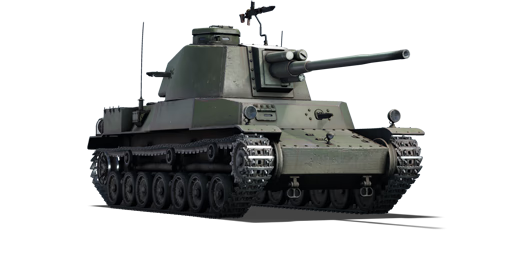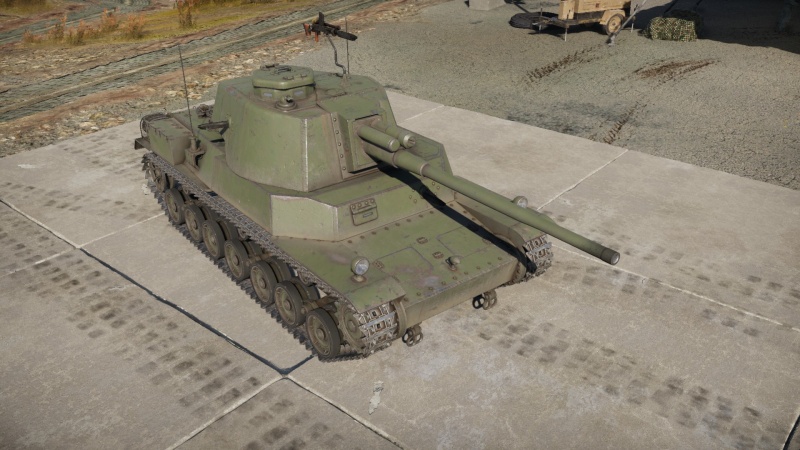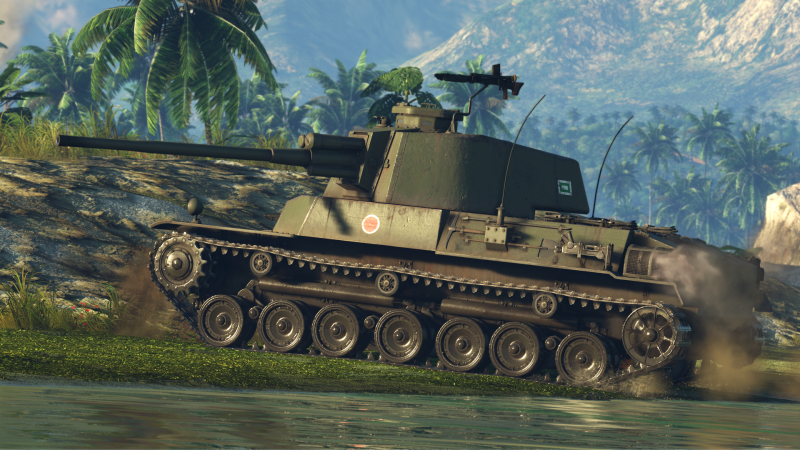Difference between revisions of "Chi-To"
(Undo revision 187711 by U136146036 (talk)) |
(Undo revision 187698 by U136146036 (talk)) |
||
| Line 90: | Line 90: | ||
! Visual<br>discrepancy | ! Visual<br>discrepancy | ||
|- | |- | ||
| − | | '''55''' || 40 ''(+15)'' || 34 ''(+21)'' || 28 ''(+27)'' || | + | | '''55''' || 40 ''(+15)'' || 34 ''(+21)'' || 28 ''(+27)'' || 22 ''(+33)'' || 10 ''(+45)'' || 0 ''(+55)'' || No |
|- | |- | ||
|} | |} | ||
Revision as of 20:09, 20 June 2024
| This page is about the Japanese medium tank Chi-To. For the late version, see Chi-To Late. |
Contents
Description
The Type 4 Chi-To (四式中戦車 「チト」) was developed as a counter to the ever-pressing danger the Sherman possessed over Japanese 1930s infantry based tanks such as the Ha-Go and Chi-Ha. The main development point of the Chi-To (and its heavier counterpart, the Chi-Ri II) was the new high-velocity long barrel 75 mm and a new hull design over the Chi-Ha / Chi-He family allowing for larger upgrades in armour, engine, and cannons. However, due to delays in hull production and lengthy cannon development, the Chi-To would only be ready in 1945 for evaluation, and the Chi-Nu and Ho-Ni III were built as stopgap measures to fill the gap of Sherman-capable competitors until the Chi-To was fully ready.
It was introduced along with the initial Japanese Ground Forces tree in Update 1.65 "Way of the Samurai". Playing the Type 4 Chi-To can give the player a new impression of the Japanese tree line and a lasting one considering many of the Japanese tanks after it follow the same pattern - a tank with a very powerful cannon, decent mobility, but rather fragile armour. The armour plus the tank's rather long reload means that the Chi-To is meant more for a long-distance shoot-out than a close encounter.
General info
Survivability and armour
Armour type:
- Rolled homogeneous armour
- Cast homogeneous armour (Gun mantlet, Machine gun port)
| Armour | Front | Sides | Rear | Roof |
|---|---|---|---|---|
| Hull | 75 mm (17°) Front plate 20 mm (76°) Front glacis 75 mm (16°), 20 mm (58°) Lower glacis 50 mm (12°) Front cheeks 50 mm (0-66°) Machine gun port |
35 mm (12-30°) Top 35 mm Bottom |
20 mm (73°) Top 35 mm Center 20 mm (48°) Bottom |
20 mm |
| Turret | 75 mm (16°) Turret front 50-75 mm (10°) Gun mantlet |
50 mm (15-16°) 50 mm (0-65°) Right machine gun port |
50 mm (15-50°) Turret rear 10 mm Turret rear underside |
20 mm |
| Cupola | 75 mm | 75 mm | 75 mm | 20 mm |
Notes:
- Suspension wheels are 15 mm thick while tracks are 20 mm thick.
- 10 mm RHA plates are scattered on the lower side hull.
- Turret ring is 20 mm thick.
Mobility
| Game Mode | Max Speed (km/h) | Weight (tons) | Engine power (horsepower) | Power-to-weight ratio (hp/ton) | |||
|---|---|---|---|---|---|---|---|
| Forward | Reverse | Stock | Upgraded | Stock | Upgraded | ||
| Arcade | 50 | 10 | 30.5 | 620 | 954 | 20.33 | 31.28 |
| Realistic | 45 | 9 | 354 | 500 | 11.61 | 16.39 | |
Modifications and economy
Armaments
Main armament
| 75 mm Type II Model II | Turret rotation speed (°/s) | Reloading rate (seconds) | |||||||||||
|---|---|---|---|---|---|---|---|---|---|---|---|---|---|
| Mode | Capacity | Vertical | Horizontal | Stabilizer | Stock | Upgraded | Full | Expert | Aced | Stock | Full | Expert | Aced |
| Arcade | 55 | -10°/+20° | ±180° | N/A | 12.1 | 16.7 | 20.3 | 22.5 | 23.9 | 8.45 | 7.48 | 6.89 | 6.50 |
| Realistic | 7.6 | 8.9 | 10.8 | 11.9 | 12.7 | ||||||||
Ammunition
| Penetration statistics | |||||||
|---|---|---|---|---|---|---|---|
| Ammunition | Type of warhead |
Penetration @ 0° Angle of Attack (mm) | |||||
| 10 m | 100 m | 500 m | 1,000 m | 1,500 m | 2,000 m | ||
| Type 1 APHE | APHE | 149 | 146 | 133 | 118 | 105 | 93 |
| Type 4 Kou | APHE | 151 | 148 | 137 | 124 | 112 | 101 |
| Type 90 HE | HE | 17 | 17 | 15 | 14 | 12 | 11 |
| Shell details | ||||||||||||
|---|---|---|---|---|---|---|---|---|---|---|---|---|
| Ammunition | Type of warhead |
Velocity (m/s) |
Projectile mass (kg) |
Fuse delay (m) |
Fuse sensitivity (mm) |
Explosive mass (TNT equivalent) (g) |
Ricochet | |||||
| 0% | 50% | 100% | ||||||||||
| Type 1 APHE | APHE | 865 | 6.56 | 1.3 | 15 | 84.8 | 47° | 60° | 65° | |||
| Type 4 Kou | APHE | 865 | 6.75 | 1.2 | 14 | 80.64 | 47° | 60° | 65° | |||
| Type 90 HE | HE | 830 | 6.17 | 0.2 | 0.1 | 490 | 79° | 80° | 81° | |||
Ammo racks
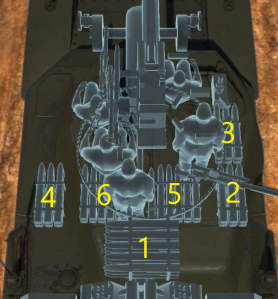
| Full ammo |
1st rack empty |
2nd rack empty |
3rd rack empty |
4th rack empty |
5th rack empty |
6th rack empty |
Visual discrepancy |
|---|---|---|---|---|---|---|---|
| 55 | 40 (+15) | 34 (+21) | 28 (+27) | 22 (+33) | 10 (+45) | 0 (+55) | No |
Note:
- Turret and hull sides empty: 22 (+33) shells.
Machine guns
| 7.7 mm Type 97 | ||||
|---|---|---|---|---|
| Mount | Capacity (Belt) | Fire rate | Vertical | Horizontal |
| Pintle | 1,000 (20) | 499 | -10°/+70° | ±60° |
| Hull | 3,000 (20) | 499 | ±8° | ±8° |
Usage in battles
As previously stated, the Chi-To best performs in the role of sniper, engaging hulldown at medium to long range against opposing medium tanks. The good gun depression, average mobility, and good reverse speed allow you to make it to good positions at an average pace and allow you to reverse back into cover when reloading.
Against most heavies such as the IS-1/2, Tiger, or Panther, it is only worthwhile to engage if you are already entrenched in a solid defensive position. Your gun's lack of APCBC gives you poor performance against slopes and rounded armour on the IS, Panther, and angled Tigers, making any ranged engagement near useless. Against tanks such as the Jumbo 75 or 76, it is best to disengage and flank them or have teammates flank them. Against all other medium tanks, shots to the hull will suffice at most range.
The M4A3E2 Jumbo could be a menace if not handled properly as they are nigh impenetrable from the front due to its thick armour. Either try for a very precise shot through the MG port in the front or shoot the armour behind the tracks if they are angled. The best way to deal with a Sherman Jumbo is to shoot it through the side or between the side plate and the tracks. There is a small gap between the top of the tracks and the bottom of the side plate that can be easily penetrated by the Chi-To Late, and a successful penetration here usually results in a one-shot, or a destroyed/alight engine. This weak spot is relatively easy to exploit as most Jumbo drivers make the mistake of angling their armour, which gives you full view of this weak spot. If you are struggling to hit it, then a shot through the drive wheel at an angle of 45º or more usually works quite well also. You should feel no pressure to get this right the first time, as a well-angled Chi-To Late can reliably bounce the Jumbo's shells, unless the Jumbo in question happens to be sporting the 76mm M1A1 cannon.
The IS series of tanks can also be a bit of a bother to deal with. At this battle rating, you may find the IS-1, IS-2 or IS-2 mod. 1944 (rare). However, they can be defeated by exploiting the shot trap on the turret front (requires some luck), shooting the driver's hatch on the front or the gun mantlet (requires extreme precision and luck), shooting the lower frontal plate (the most reliable way to kill an IS) or shooting the frontal armour plate from a 90º angle. That being said, your tank can still one-shot the IS series you'll face by shooting directly beneath the turret ring.
You may encounter the German "Big Cat" tanks (Tiger H1, Tiger E, Panther D, Panther A) if you get seriously up tiered. In this case the best thing you can do is hit them from the side, which usually results in a one-shot. If facing a Tiger (or any German Big Cat for that matter) from the front, you should retreat. However, if his frontal plate is not angled, then it might be worth a shot to shoot between the machine gun port and driver's hatch, which will result in a one-shot. As for the panther, try to exploit the shot trap on the turret, but only as a last resort. Your first port of call should be to shoot the drive wheel, basically following the same tactics you'd use for dealing with a Sherman Jumbo.
As for some other enemies:
- Churchill VII: do not engage from the front at all. Sneak around to the side and shoot there.
- ARL-44: shoot the sides. It's not worth facing this tank head on, it's too much of a risk.
- ARL-44 (ACL-1): aim for the turret if you face this tank from the front, then finish it from the sides. Be careful not to get shot.
- M6A1: the frontal armour on this thing can be a bit fiddly. Aim for a spot that doesn't seem to have more than one armour plate layered on it.
Most tanks you face can penetrate you frontally if they shoot your frontal plate when it is not angled. It is recommended to get the first shot off and then retreat, and make a second surprise attack. Most of the time, a penetration results in a one-shot with this tank. You can penetrate pretty much any medium or light tank frontally by shooting the upper front plate, so use that to your advantage.
Pros and cons
Pros:
- Powerful 75 mm cannon, good penetration and very low shell drop-off.
- A very powerful tank at 4.3, can tackle all foes at its BR bracket.
- Decent gun depression of -11°
- Ammo in the turret can be emptied by carrying 15 less ammo.
- Decent top armour, enough to resist strafing aircraft weapons.
Cons:
- Atrocious optics
- Armour is average and mostly flat and unangled, like the Panzer IV.
- The Chi-To is asymmetric and is a large tank, it is difficult to hide from enemies.
- Reload rate quite slow.
- Angling front armour can expose the 50 mm hull cheek armour.
- Very hard to turn on the spot, especially when stock.
History
Development
The lackluster performance of Japanese tanks in World War II called for the development of newer medium tanks in the Imperial Japanese Army. The standard tank of the time was the Type 97 Chi-Ha, which has its chassis used in many expedient models to provide a bigger gun for the Japanese inventory such as the Chi-Ha Kai, Type 1 Chi-He, Type 2 Ho-I, and Type 3 Chi-Nu. By the time of Chi-Nu, however, the Chi-Ha chassis was becoming outdated and so a new tank design using an improved chassis was needed for future development.[1]
In 1943, development started of the Chi-To tank, which features a new chassis and more powerful engine. Its armament is a 75 mm gun based off the Type 88 anti-aircraft gun, giving it a high-velocity weapon. Armour on the tank was welded and was quite thick in comparison to its predecessor at 75 mm thick. The tank was accepted for service in 1944 and was expected to enter mass production with 20 per month at Mitsubishi and 5 per month at Kobe-Seiko. In terms of Japanese armour development, the Chi-To was the most sophisticated tank to enter production levels.[1]
War's End
Despite its potential, the Type 4 Chi-To was never made in large numbers. At the war's end, only six chassis were made, with only two of those made into tanks.
The two Type 4 produced were cast into Lake Hamana between the 23 and the 28 August 1945 to avoid their capture. One was found by the U.S. occupation forces following Japan's surrender in World War II. The tank was then transported to Aberdeen Proving Grounds for tests and would eventually scrap them in October 1952.[2]
The second tank is still believed to be at the bottom of the lake. A project to find it was launched in 2013 by SM@Pe, a group of people from Hamamatsu. Inhabitants, volunteers, divers and the Windy Network Corp ( a marine studies company from Tôkyô who founded a trainning plane of the Japanese imperial army in the lake Towada in 2010) participated to research, supported by the use of a sonar and testimonials, including former soldiers who allegedly participated in the launching operation. The research did not give anything.
Media
- Skins
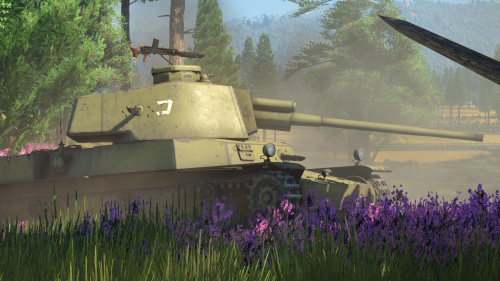
See also
Links to the articles on the War Thunder Wiki that you think will be useful for the reader, for example:
- reference to the series of the vehicles;
- links to approximate analogues of other nations and research trees.
External links
References
| Mitsubishi Heavy Industries (三菱重工業株式会社) | |
|---|---|
| Light Tanks | |
| Type 95 | Ha-Go · Ha-Go Commander |
| Medium Tanks | |
| Type 89 | I-Go Ko |
| Type 97 | Chi-Ha · Chi-Ha Kai |
| Type 1 | Chi-He · Chi-He (5th Regiment) |
| Type 3 | Chi-Nu · Chi-Nu II |
| Type 4 | Chi-To · Chi-To Late |
| Type 5 | Chi-Ri II |
| SPGs | |
| Chi-Ha Derived | Ho-Ro |
| Chi-He Derived | Ho-I |
| Chi-Ri Derived | Ho-Ri Prototype · Ho-Ri Production |
| Other | Na-To · Ro-Go Exp. |
| Captured | ␗Chi-Ha · ␗Chi-Ha Kai |
| Note | Most tank designs would be contracted by the Army Technical Bureau to Mitsubishi |
| See also | Mitsubishi Heavy Industries Ltd. (Post-War) |
| Japan medium tanks | |
|---|---|
| Type 97 | Chi-Ha · Chi-Ha Kai · Chi-Ha Kai TD · Chi-Ha Short Gun |
| Type 1 | Chi-He · Chi-He (5th Regiment) · Ho-I |
| Type 3 | Chi-Nu · Chi-Nu II |
| Type 4 | Chi-To · Chi-To Late |
| Type 5 | Chi-Ri II |
| Type 61 MBT | ST-A1* · ST-A2* · ST-A3* · Type 61 |
| Type 74 MBT | ST-B2* · Type 74 (C) · Type 74 (E) · Type 74 (F) · Type 74 (G) |
| Type 90 MBT | Type 90 · Type 90 (B) · Type 90 (B) "Fuji" |
| Type 10 MBT | TKX (P)* · TKX* · Type 10 |
| Other | Ka-Chi |
| USA | ▅M4A3 (76) W · ▅M47 |
| *Prototype | |


